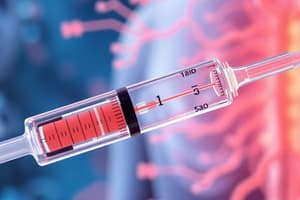Podcast
Questions and Answers
What is the recommended blood sugar decrease per hour while on an insulin drip?
What is the recommended blood sugar decrease per hour while on an insulin drip?
- 20% per hour
- 10% per hour (correct)
- 50 mg/dL per hour (correct)
- 5% per hour
In which scenario may subcutaneous insulin absorption be inadequate?
In which scenario may subcutaneous insulin absorption be inadequate?
- Diabetic patient with normal blood sugar
- Patient with good hydration
- Patient with hypovolemia (correct)
- Patient undergoing surgery
What is the peak action time for rapid-acting insulins?
What is the peak action time for rapid-acting insulins?
- 120 minutes
- 60 minutes
- 30 minutes
- 90 minutes (correct)
Which of the following insulins does not require a wait time prior to a meal?
Which of the following insulins does not require a wait time prior to a meal?
What action should be taken if blood sugar decreases faster than 50 mg/dL per hour?
What action should be taken if blood sugar decreases faster than 50 mg/dL per hour?
What is the most common complication experienced by patients with diabetes?
What is the most common complication experienced by patients with diabetes?
What condition may result from a blood sugar level that is too high?
What condition may result from a blood sugar level that is too high?
What should patients do to achieve better long-term outcomes in diabetes management?
What should patients do to achieve better long-term outcomes in diabetes management?
Which of the following symptoms may indicate hypoglycemia?
Which of the following symptoms may indicate hypoglycemia?
What is a potential consequence of tight control of blood glucose levels?
What is a potential consequence of tight control of blood glucose levels?
What is the likely outcome when a patient with diabetes develops hypoglycemic unawareness?
What is the likely outcome when a patient with diabetes develops hypoglycemic unawareness?
What type of intervention is necessary for moderate hypoglycemia?
What type of intervention is necessary for moderate hypoglycemia?
Which body mechanisms are typically activated to combat a significant drop in blood glucose levels?
Which body mechanisms are typically activated to combat a significant drop in blood glucose levels?
What primarily causes glucose to spill into the urine in patients with elevated blood glucose levels?
What primarily causes glucose to spill into the urine in patients with elevated blood glucose levels?
What is the typical serum blood glucose level at which glucose begins to appear in urine?
What is the typical serum blood glucose level at which glucose begins to appear in urine?
Which symptom is NOT typically associated with Diabetic Ketoacidosis (DKA)?
Which symptom is NOT typically associated with Diabetic Ketoacidosis (DKA)?
When managing DKA, what is the primary concern regarding fluid replacement?
When managing DKA, what is the primary concern regarding fluid replacement?
What can occur if dextrose is administered before thiamine to malnourished or alcoholic patients?
What can occur if dextrose is administered before thiamine to malnourished or alcoholic patients?
What should the initial IV fluid bolus consist of for DKA treatment?
What should the initial IV fluid bolus consist of for DKA treatment?
In diabetic ketoacidosis (DKA), what primarily causes blood glucose levels to rise?
In diabetic ketoacidosis (DKA), what primarily causes blood glucose levels to rise?
Why should potassium replacement be initially avoided in DKA treatment?
Why should potassium replacement be initially avoided in DKA treatment?
Which method is generally considered less desirable for managing hyperglycemia in DKA compared to an insulin infusion?
Which method is generally considered less desirable for managing hyperglycemia in DKA compared to an insulin infusion?
Which type of acidosis is associated with diabetic ketoacidosis?
Which type of acidosis is associated with diabetic ketoacidosis?
What is the primary cause of hypoglycemia?
What is the primary cause of hypoglycemia?
What characteristic breath odor might you expect in a patient with DKA?
What characteristic breath odor might you expect in a patient with DKA?
What is the most effective treatment for a conscious patient experiencing hypoglycemia?
What is the most effective treatment for a conscious patient experiencing hypoglycemia?
How often should blood glucose levels be checked in patients with hypoglycemia who require close monitoring?
How often should blood glucose levels be checked in patients with hypoglycemia who require close monitoring?
What should be done if a patient has an altered level of consciousness due to hypoglycemia?
What should be done if a patient has an altered level of consciousness due to hypoglycemia?
What metabolic process occurs due to the lack of insulin in diabetic patients, leading to ketone body production?
What metabolic process occurs due to the lack of insulin in diabetic patients, leading to ketone body production?
What bodily effect can high blood glucose levels lead to, due to the loss of glucose in urine?
What bodily effect can high blood glucose levels lead to, due to the loss of glucose in urine?
Why is glucose gel preferred over glucose tablets in certain situations?
Why is glucose gel preferred over glucose tablets in certain situations?
What is the correct concentration of dextrose in a 50% dextrose solution?
What is the correct concentration of dextrose in a 50% dextrose solution?
Which condition manifests as amnesia, confabulation, attentional deficit, disorientation, and vision impairment?
Which condition manifests as amnesia, confabulation, attentional deficit, disorientation, and vision impairment?
What complication can arise from administering dextrose solutions more concentrated than 5% too quickly?
What complication can arise from administering dextrose solutions more concentrated than 5% too quickly?
What is a significant difference between ketoacidosis and lactic acidosis?
What is a significant difference between ketoacidosis and lactic acidosis?
What should be done if IV access is not possible in a patient with hypoglycemia?
What should be done if IV access is not possible in a patient with hypoglycemia?
Which of the following is NOT a sign of hypoglycemia?
Which of the following is NOT a sign of hypoglycemia?
What characterizes type 1 diabetes?
What characterizes type 1 diabetes?
Which type of diabetes is primarily associated with insulin resistance?
Which type of diabetes is primarily associated with insulin resistance?
What is the primary role of insulin in the body?
What is the primary role of insulin in the body?
Which statement about oral hypoglycemic medications is true?
Which statement about oral hypoglycemic medications is true?
What is the main reason paramedics are likely to administer regular insulin?
What is the main reason paramedics are likely to administer regular insulin?
Which of the following best explains the difference between type 1 and type 2 diabetes?
Which of the following best explains the difference between type 1 and type 2 diabetes?
What role do potassium levels play in relation to insulin?
What role do potassium levels play in relation to insulin?
What is a key factor that distinguishes various types of insulin?
What is a key factor that distinguishes various types of insulin?
Flashcards
Type 1 Diabetes
Type 1 Diabetes
A condition where the pancreas doesn't produce enough insulin, causing the body's cells to be unable to take in sugar for energy.
Type 2 Diabetes
Type 2 Diabetes
A condition where the body produces insulin but doesn't use it properly, resulting in high blood sugar levels.
Insulin
Insulin
A hormone produced by the pancreas that helps the body's cells use sugar for energy.
Insulin Resistance
Insulin Resistance
Signup and view all the flashcards
Oral Hypoglycemic Medications
Oral Hypoglycemic Medications
Signup and view all the flashcards
Hypoglycemia
Hypoglycemia
Signup and view all the flashcards
Onset of Action
Onset of Action
Signup and view all the flashcards
Duration of Action
Duration of Action
Signup and view all the flashcards
Hypoglycemic Unawareness
Hypoglycemic Unawareness
Signup and view all the flashcards
Moderate Hypoglycemia
Moderate Hypoglycemia
Signup and view all the flashcards
Blood Glucose Control
Blood Glucose Control
Signup and view all the flashcards
Catecholamines, Glucagon, and Cortisol
Catecholamines, Glucagon, and Cortisol
Signup and view all the flashcards
Long-Term Diabetes Complications
Long-Term Diabetes Complications
Signup and view all the flashcards
Oral Glucose
Oral Glucose
Signup and view all the flashcards
IV Dextrose
IV Dextrose
Signup and view all the flashcards
Glucagon
Glucagon
Signup and view all the flashcards
Glucagon Injection
Glucagon Injection
Signup and view all the flashcards
Hypertonic Dextrose Solution
Hypertonic Dextrose Solution
Signup and view all the flashcards
Dextrose Solution Concentration
Dextrose Solution Concentration
Signup and view all the flashcards
IV insulin for DKA
IV insulin for DKA
Signup and view all the flashcards
Subcutaneous insulin in poor perfusion
Subcutaneous insulin in poor perfusion
Signup and view all the flashcards
Blood sugar monitoring during insulin therapy
Blood sugar monitoring during insulin therapy
Signup and view all the flashcards
Rapid-acting insulins
Rapid-acting insulins
Signup and view all the flashcards
Rapid-acting insulin administration timing
Rapid-acting insulin administration timing
Signup and view all the flashcards
Diabetic Ketoacidosis (DKA)
Diabetic Ketoacidosis (DKA)
Signup and view all the flashcards
Ketoacidosis
Ketoacidosis
Signup and view all the flashcards
Lactic Acidosis
Lactic Acidosis
Signup and view all the flashcards
Dehydration in DKA
Dehydration in DKA
Signup and view all the flashcards
Wernicke-Korsakoff Syndrome
Wernicke-Korsakoff Syndrome
Signup and view all the flashcards
Thiamine before Dextrose
Thiamine before Dextrose
Signup and view all the flashcards
Glucagon's Effect
Glucagon's Effect
Signup and view all the flashcards
Diabetes
Diabetes
Signup and view all the flashcards
Glucose Spilling
Glucose Spilling
Signup and view all the flashcards
Fruity Breath
Fruity Breath
Signup and view all the flashcards
Fluid Replacement in DKA
Fluid Replacement in DKA
Signup and view all the flashcards
Insulin Therapy for DKA
Insulin Therapy for DKA
Signup and view all the flashcards
Potassium Replacement in DKA
Potassium Replacement in DKA
Signup and view all the flashcards
High Potassium in DKA
High Potassium in DKA
Signup and view all the flashcards
Study Notes
Endocrine Emergencies
- Endocrine emergencies involve fast-acting conditions related to the endocrine system, such as diabetes.
Overview of Diabetes
- Diabetes is a disease involving dysfunction in the pancreas.
- Insulin is crucial for converting sugars into energy for the body.
- Diabetes exists in two primary forms: type 1 and type 2.
- Type 1 diabetes patients do not produce insulin, so their cells cannot absorb sugar for energy, much like a car without fuel.
- Type 2 diabetes patients produce insulin but their body's cells do not properly utilize it, leading to insulin resistance.
- The majority of people with diabetes have type 2 diabetes.
- Insulin is used in type 1 diabetes and some type 2 diabetes patients.
- Insulin encourages the uptake of glucose by body cells and reduces blood sugar levels.
- Glucose enters cells, and potassium follows.
- Oral hypoglycemic medications are used for managing most type 2 diabetes cases.
Overview of Diabetes (Continued)
- These medications work on the insulin-producing cells in the pancreas or aid insulin function in the body.
- Some oral hypoglycemic medications increase the tendency towards hypoglycemia in certain groups like the elderly and people with kidney or liver diseases.
Type 1 Diabetes
- The disease is considered chronic.
- It is treatable with medications only.
Type 2 Diabetes
- This disease is considered chronic.
- It can be treated through lifestyle changes and medication.
Hypoglycemia
- Hypoglycemia (low blood sugar) is a potentially life-threatening complication of diabetes and is among the most common complications.
- It is often referred to as insulin shock.
- Research shows that strictly controlling blood sugar levels in diabetic patients can lead to fewer complications.
- Factors affecting the risk of hypoglycemia include diet and the dosage of medications.
- Maintaining appropriate blood sugar is important to prevent long-term complications.
- Mild hypoglycemia can typically be treated with oral glucose.
- More severe cases of hypoglycemia require medical intervention but can often have little to no warning signs.
- A significant drop in blood sugar triggers a defense mechanism in the body through chemicals like catecholamines, glucagon, and cortisol to raise glucose and improve blood sugar toward the brain.
- Hypoglycemic unawareness is a condition where patients do not detect symptoms of hypoglycemia before nerve damage occurs.
- Hypoglycemia can result from inadequate sugar intake or excessive insulin intake.
- Exercise or physical activity can cause blood sugar levels to drop quickly.
- Factors such as poor perfusion and shock can interfere with insulin absorption, potentially leading to slower onset effects.
Hypoglycemia Management
- When possible, oral glucose is the preferred treatment.
- Consciousness should be evaluated before deciding on treatment.
- Oral glucose can be administered as glucose tablets or gel.
- Glucose gel is easier to tolerate and helps prevent choking if consciousness is altered.
Management (Parenteral Glucose)
- When consciousness is altered or an airway is compromised, intravenous (IV) glucose administration is preferred.
- The most common 50% dextrose solution is used for emergency situations. This contains 50 grams of dextrose per 100 mL.
- Pre-filled syringes containing dextrose (50 mL, 25g) are frequently utilized in emergency scenarios.
- Other concentrations include 25% dextrose, which is 25 g/100 ml solution.
- 10% dextrose is 10 g/100 ml.
- Dextrose concentrations of more than 5% can cause pain and irritation on injection. These should be administered slowly and not via intramuscular or subcutaneous routes.
- If IV access is impossible, IM glucagon or IV glucose administration can be necessary.
Diabetes Ketoacidosis (DKA) Management
- DKA treatment involves correcting dehydration and acidosis using IV fluids and insulin.
- Fluid replacement should be gradual, considering potential weight loss and deterioration during the three-week period.
- IV fluid administration should not be overly aggressive unless cardiovascular instability is observed.
- 15 to 20 mL per kilogram initial dosage for normal saline is recommended to adults.
- IV fluid should ideally not include potassium during the early stages, due to high potassium likely already present.
- Once urine output is established, and electrolyte status can be determined at a hospital, potassium replacement becomes increasingly important.
- Prehospital treatment should involve isotonic solution such as normal saline or Ringer's lactate.
Management (Insulin Administration)
- Many EMS agencies do not carry insulin, so IV fluid administration is often sufficient in the early stages to manage hyperglycemia and metabolic acidosis until proper treatment can be provided.
- IV insulin can be administered as a bolus or drip if available.
- IV bolus insulin use is less desirable than continuous insulin infusion.
- IV insulin is more effective than intramuscular or subcutaneous injection, particularly in the initial treatment of DKAT.
Management (Further Considerations)
- In patients with poor hypovolemic or shock-related perfusion, subcutaneous insulin may not be effectively absorbed, leading to a slow onset of action.
- Blood sugar monitoring every 30-60 minutes is crucial during insulin administration.
- The desired response is a 10% blood glucose decrease per hour, or less than 50mg/dL per hour. If exceeding 50 mg/dL decrease, the insulin rate should be reduced.
- If thiamine is administered before dextrose, it can prevent Wernicke-Korsakoff syndrome, an acute brain disorder in those with nutritional deficiencies. This is particularly important in alcoholic or malnourished patients.
- DKA treatment also depends on an adequate airway and circulatory conditions as well as the person's level of consciousness.
Rapid-Acting Insulins
- Insulin lispro (Humalog), insulin aspart (NovoLog), and insulin glulisine (Apidra) are rapid-acting insulins.
- Their structure makes them ideal for type 1 diabetes treatment.
- The onset of action is typically within 10 minutes, and peak action occurs around 90 minutes, with duration around 2-4 hours.
- These insulins can be administered immediately after meals, without a 30-minute delay.
Studying That Suits You
Use AI to generate personalized quizzes and flashcards to suit your learning preferences.




